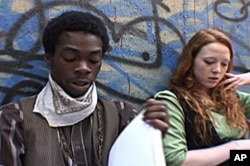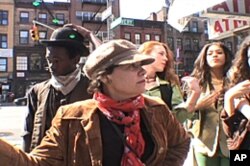One of New York's smaller theater troupes, a nonprofit company of teenage actors called Downtown Art, is staging an unusual musical this month on several streets and alleys in lower Manhattan. The Bowery Wars, Part 1 by founder and director, Ryan Gilliam, is about the early 20th-century struggle over what was then the city’s seedy, vice-ridden entertainment district, along the Bowery. The play’s first act takes place on some of the streets where two Irish gangs battled for supremacy during the hotly contested mayoral election of 1903.
"There were saloons and illegal gambling joints, and it was a great place for any kind of criminal activity to be nurtured," Gilliam says of the Bowery in that era. "Tammany Hall, the Democratic party of the time, had been kicked out for extensive corruption and graft two years prior, and was trying to reorganize itself and retake its leadership position. And Tammany Hall’s base of support was on the Bowery and Lower East Side.”
The actors, ranging in age from 13 to 19, dance, quarrel, flirt and even battle through the first act, covering several kilometers of lower Manhattan. The audience follows along. Yet passersby hear nothing and could mistake the troupe for a company of mimes. That’s because music and dialogue in the first act is heard only on earpieces worn by both the audience and the players, who mouth their lines in sync with those pre-recorded on mp3s.
"We don’t clear the streets," says Gilliam. "We just work within the confines of everything else that’s going on, all the other people that are passing through."
At a recent performance, for example, several actors performing in a churchyard almost bumped into a bridal party from a wedding inside the church. Crossing the street is a more typical danger. Gilliam says the actors keep an eye on traffic even as they stay in character.
The second act is staged more conventionally, in a vacant lot owned by Downtown Art. The audience, many of them parents, sits on folding chairs. A band led by Michael Hickey, Downtown Art’s composer-in-residence, performs as the play ends at a dance where a young man and woman from from opposing gangs meet. Gilliam says next year’s production, The Bowery Wars, Part Two, will continue their story, inspired by Shakespeare’s Romeo and Juliet.
Many of the teens have been in the company since they were 13. Jeanne Kissera says she learned about the troupe when she was nine and waited until she was old enough to join. "As you can tell, this is not the average theater stage," Kissera said during rehearsal at the lot. "I just think it’s really kind of original and innovative and an interesting approach to theater."
"More than a theater, it’s also a community," said Max Molishever, in his last season with the company. He said he’s made his closest friends through the plays. "Age is not a big issue here. We are all family. I think that’s Downtown Art’s greatest strength."
"I’m always thinking about diversity when I’m putting together a company for the year," Gilliam says. But, she's also "looking for a sense of real excitement and interest. If I’m seeing somebody who’s looking very lit up, even if they’re silent, I’m paying attention to that. Anyone who’s that kind of excited about doing something creative has got talent. They just haven’t had the chance yet to put it into practice."
Gilliam has a degree in theater management from the Yale School of Drama, but became a playwright when she couldn’t find a play with enough female characters. She estimates she’s written close to 20 plays since 1997 - the last several with an eye to performing them outdoors. She says that's because Downtown Art’s building in the East Village, which it bought from the city for $1, is being renovated.
"I felt resistant to spending all our money on renting theaters," she says. "So I started looking around for other options, and I began thinking about performing outdoors and on the streets. And then I wanted to do work that related to the streets, and that became my investigation and the history of the Lower East Side.”
Last year, the company performed her play, The Waistmakers’ Opera, which Gilliam describes as a "rock opera."
It was about a strike that took place in 1909 by the women shirt-makers, she says. "It was a year before the Triangle Factory Fire, which was a devastating fire and a landmark in New York history. The story was a way of telling who these young women were and what they had taken on and fought for."
Costumes and sets are not the point in Downtown Art productions, she says. "When you don’t have the resources, you have to be inventive. That’s just part of theatrically, which I’ve always liked about being a poor theater. The audience is so willing to give you their imagination. They really often only need suggestions and they’re quite willing to fill in the rest."
Gilliam says the goal of Downtown Art is not to train the actors but to nurture their creative spirit. She says that’s why she keeps the company going on a budget of just $80,000 a year. "I think they gain tremendous confidence in their ability to do something new and succeed at it. One of the things I could tell when I was working with teens, helping them develop creative work, was that it not only was enjoyable as an artistic process, but we actually looked happier after two hours of rehearsal. It was making a difference in all of our lives," Gilliam said.









